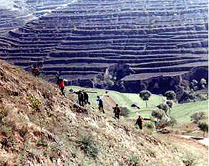 While heavy downpours have been repeatedly reported in many parts of the country, large areas in northern China have been hit by prolonged drought and high temperatures, with 7.9 million rural people and 6.3 million livestock facing a severe shortage of drinking water, according to official sources.
While heavy downpours have been repeatedly reported in many parts of the country, large areas in northern China have been hit by prolonged drought and high temperatures, with 7.9 million rural people and 6.3 million livestock facing a severe shortage of drinking water, according to official sources.
More than 8 million hectares of crops have been affected, with 33 percent of them facing the prospect of failure because of the persistent drought, according to the latest reports released Wednesday by Beijing-based State Flood-Control and Drought Mitigation Headquarters (SFCDMH).
Drought is likely to worsen in some areas in the following weeks, with drinking water becoming scarcer for millions of rural people in remote areas in Northwest China forcing them to rely on rainwater gathered in catchment systems and stored in cisterns.
At present, most of these cisterns are drying up because of the lack of rainfall since late July, usually a period of heavy rainfall marking the beginning of the major flood season in North, Northwest and Northeast China and areas north of the Yangtze River, water officials warned.
"There has not been enough rain in most parts of Northwest China since late last month, while precipitation has been less than 25 millimeters in most areas in Northeast China, northern parts of North China and northern areas north of the Yellow and Huaihe rivers,'' SFCDMH experts said.
Over the past 10 days, the few showers have not been enough to increase soil moisture in the scorched lands in drought-stricken provinces such as Hebei, Shanxi, Shandong, Sichuan and Gansu, and in the Inner Mongolia Autonomous Region.
During the period, extremely high temperatures ranging from 35 C to 43 C, the highest ever recorded in 50 years, repeatedly occurred in many areas, such as Shijiazhuang in Hebei and Feicheng in Shandong, because of a lingering subtropical high-pressure area.
Such hot days have exacerbated the loss of soil moisture and evaporation in drought-prone areas.
The unusual hot weather and scarcity of rain have created a serious hydrological imbalance: water reservoirs have been emptied, wells have dried up, the ground water table has dropped and crops are being damaged in more and more areas.
Water volumes in most of China's major rivers were also insufficient by the end of last month compared with supplies in the corresponding period of previous years.
Statistics released this week by water authorities indicate that by late July runoff in the Yangtze, Yellow, Haihe, Liaohe and Songhua rivers was 30 to 90 percent less in the same period last year.
Water levels in large reservoirs supplying urban people in China's 16 provinces has also dropped drastically.
By August 1, only 25.2 billion cubic meters of water, 5.2 billion cubic meters less than at the same time last year, were stored in the major water reservoirs in Northern China's nine provinces, autonomous regions and municipalities, including Beijing, Tianjin, Hebei, Shanxi, Heilongjiang and Inner Mongolia.
(China Daily August 8, 2002)
|

